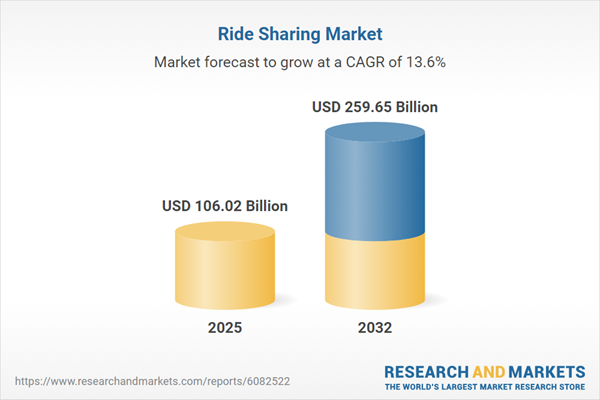Speak directly to the analyst to clarify any post sales queries you may have.
Ride sharing is reshaping urban transportation and corporate mobility strategies as organizations explore sustainable, data-driven alternatives to traditional vehicle ownership. This evolution responds to growing expectations around efficiency, accessibility, and environmental impact.
Market Snapshot: Ride Sharing Market Growth and Outlook
The ride sharing market expanded from USD 93.84 billion in 2024 to USD 106.02 billion in 2025 and is forecast to reach USD 259.65 billion by 2032, representing a CAGR of 13.56%. Senior decision-makers evaluating the sector will note that growth reflects widespread integration of digital platforms, increased adoption of electric vehicles, and a marked rise in cross-industry partnerships. Both established providers and new entrants are leveraging scalable technology to access a broader customer base in developed and emerging economies. The combination of accessible platform models and strategic collaborations is central to sustaining this upward trajectory, driving ongoing transformation in mobility management and user experience.
Scope & Segmentation
This report delivers an in-depth segmentation of the ride sharing market, empowering decision-makers to benchmark and target high-impact areas. The following segments help to pinpoint where to focus strategy and investment:
- Service Types: Car pooling, corporate ride sharing, peer-to-peer services, and standard ride offerings, each catering to unique operational requirements and customer segments.
- Platform Types: Mobile applications, third-party integrations, and web-based solutions, ensuring flexible access and supporting varied user interaction preferences.
- Operational Models: On-demand scheduling and prescheduled ride alternatives, enabling dynamic fleet management and tailored service for different market niches.
- Vehicle Ownership Structures: Company-owned and driver-owned fleet models, directly shaping cost structures, utilization rates, and the potential for partnerships.
- Vehicle Types: Portfolio including compact vehicles, electric cars, sedans, and SUVs, supporting diverse demand profiles and sustainability objectives.
- Regions: Detailed analysis of the Americas, Europe, Middle East, Africa, and Asia Pacific with dedicated focus on the United States, Canada, Mexico, and Brazil for cross-border business planning.
- Key Technologies: Artificial intelligence, machine learning, predictive analytics, integrated mobile platforms, real-time tracking, and emission-reducing transport technologies—each critical to operational efficiency and user value.
This segmented perspective enables robust competitive analysis and identifies emerging opportunities in both established and evolving ride sharing markets.
Key Takeaways
- Strategic ecosystem partnerships are expanding service diversity and promoting recurring revenue, backed by improved fleet oversight and integration of financial services.
- Adoption of AI-driven analytics is optimizing resource allocation and occupancy, supporting better demand prediction and directly influencing profitability and service excellence.
- Sustainability efforts are at the forefront as operators prioritize electric vehicle integration and form alliances around new energy to align with corporate decarbonization mandates.
- Regulatory evolution necessitates agile compliance, with organizations actively coordinating with authorities to adapt quickly to shifting safety, licensing, and privacy rules.
- Personalization, innovative safety features, and seamless multimodal integration are emerging as crucial differentiators, strengthening retention in dense urban centers and specialized segments.
Tariff Impact: Navigating U.S. Trade Policy Shifts
Changes in U.S. tariffs on vehicle imports and components are pushing acquisition and maintenance expenses higher, creating margin pressure for ride sharing operators in the region. Global providers are turning to solutions such as local procurement, revised leasing arrangements, and dynamic pricing models to navigate these challenges. Working closely with domestic manufacturers and deploying targeted technology upgrades further bolsters resilience, equipping operators to manage volatility while sustaining growth potential in an evolving policy environment.
Methodology & Data Sources
The research behind this report incorporates direct interviews with industry leaders, mobility planners, and regulators, as well as results from driver and rider surveys. Secondary data includes thorough reviews of regulatory filings, company reports, and curated industry intelligence. Quantitative findings are cross-validated through expert consultation and scenario analysis for robust accuracy.
Why This Ride Sharing Market Report Matters
- Enables senior executives to compare strategies, technology adoption, and risk management across service and operational models spanning multiple regions.
- Delivers actionable insights for optimizing operations, building strategic alliances, and advancing environmental initiatives amid shifting industry requirements.
- Supports investment decisions with segmented, validated market intelligence for benchmarking opportunities and evaluating exposure.
Conclusion
This report offers market-focused analysis and actionable data on key trends, positioning executives to anticipate evolving mobility needs and achieve long-term objectives in the ride sharing landscape.
Table of Contents
3. Executive Summary
4. Market Overview
7. Cumulative Impact of Artificial Intelligence 2025
List of Figures
Companies Mentioned
The companies profiled in this Ride Sharing market report include:- Beep, Inc.
- BlaBlaCar
- Bolt Technology OU
- Cabify España S.L.U.
- Cubic Transportation Systems, Inc.
- Curb Mobility, LLC
- Didi chuxing Technology Co. Ltd.
- Digittrix Infotech Private Limited
- FOD Mobility UK Ltd.
- GATEWAY DIGITAL
- Getaround, Inc.
- Gettaxi Limited
- Grab Holding, Inc.
- Lyft, Inc.
- Mobisoft Infotech
- Moovit Inc.
- Ola by ANI Technologies Pvt. Ltd.
- Quick Ride by iDisha Info Labs Pvt Ltd.
- Ridecell Inc.
- SkedGo Pty. Ltd.
- Trafi Ltd.
- TRANSDEV Group
- Turo Inc.
- Twogo by Schwarz Mobility Solutions GmbH
- Uber Technologies Inc.
- Wingz, Inc.
Table Information
| Report Attribute | Details |
|---|---|
| No. of Pages | 193 |
| Published | November 2025 |
| Forecast Period | 2025 - 2032 |
| Estimated Market Value ( USD | $ 106.02 Billion |
| Forecasted Market Value ( USD | $ 259.65 Billion |
| Compound Annual Growth Rate | 13.5% |
| Regions Covered | Global |
| No. of Companies Mentioned | 27 |









